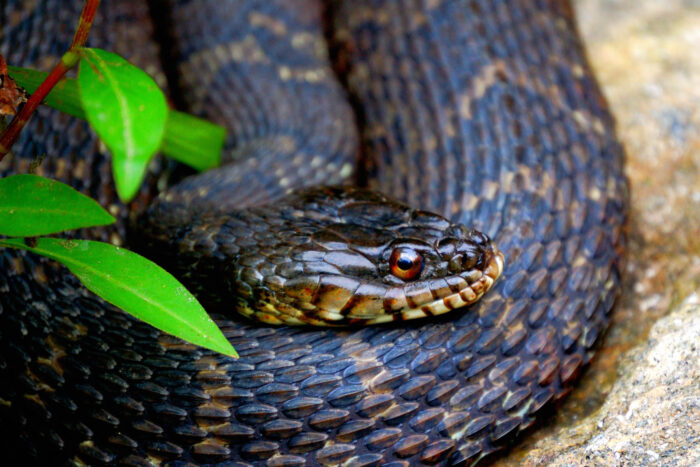Northern Water Snake
Nerodia sipedon sipedon
The northern water snake is a non-venomous aquatic snake that lives in lakes, swamps, streams and other waterways throughout the Chesapeake Bay watershed.
This section shows one large critter image at a time. Use the thumbnails that follow to select a specific image to display here.

This gallery contains a grid of small thumbnails. Selecting a thumbnail will change the main image in the preceding section.
Appearance
The northern water snake grows to be two to four feet long. They have a highly variable color and pattern and may be tan, gray, reddish or brownish-black. Older snakes are darker, often without a clear pattern.
Dark crossbands appear on their neck and forefront of their body; the dark bands are wider than the lighter-colored spaces between them. Alternating dark blotches appear on their back and sides on the lower half of their body, and half-moon-shaped spots appear on their belly. They have a double row of scales under their tail. Northern water snakes also have round pupils.
Feeding
These snakes eat small fish, worms, frogs, salamanders and crayfish and will swallow their prey alive.
Predators
Large snakes and mammals such as foxes and raccoons prey upon water snakes. They escape predators by diving underwater. When threatened, they can be aggressive and will secrete a foul-smelling odor to keep predators away.
Reproduction and life cycle
Males begin to breed within two years. Females mate when they are three years old. Females give birth to one litter of live young per year, usually in mid- to late summer. Water snakes are independent at birth.
Did you know?
- These are the most common snake seen in fresh and brackish waters in the Chesapeake region.
- Northern water snakes swim actively during the day and at night and can often be found basking on stumps, rock and branches to stay warm.
- They can stay underwater for an hour and a half without coming up for air.
- Water snakes are not venomous; however, they will bite if they feel threatened. It’s always best to keep a safe distance from all snakes and wildlife, just in case.
- Northern water snakes can be confused with the venomous cottonmouth. You can distinguish a northern water snake by its round pupils and the double row of scales under its tail.
Sources and additional information
- Life in the Chesapeake Bay by Alice Jane Lippson and Robert L. Lippson
- Chesapeake Bay: Nature of the Estuary, A Field Guide by Christopher P. White
- Animal Diversity Web: Nerodia sipedon – University of Michigan Museum of Zoology
- Northern Watersnake – Virginia Herpetological Society
